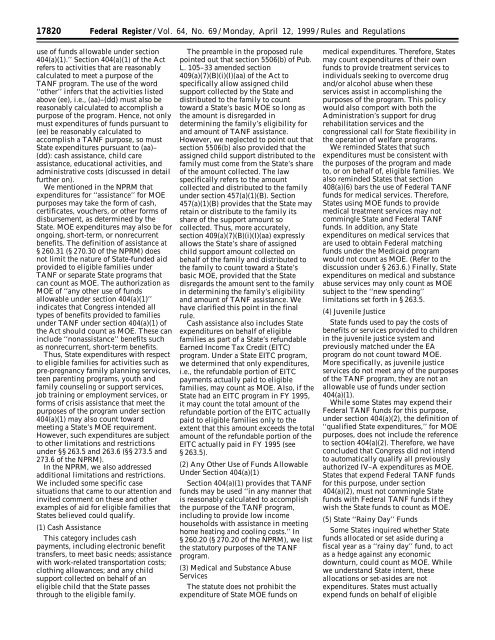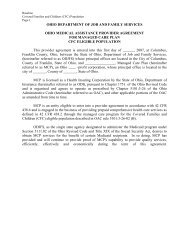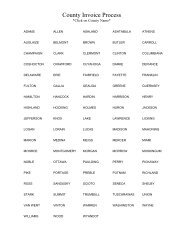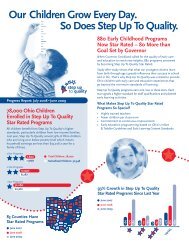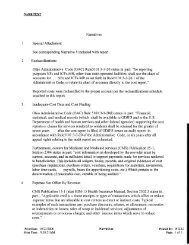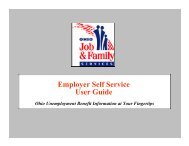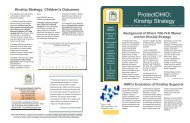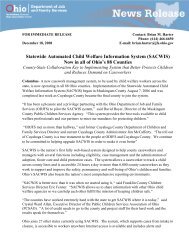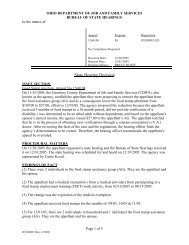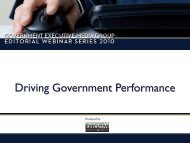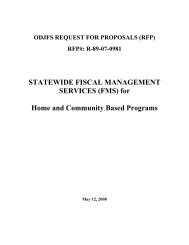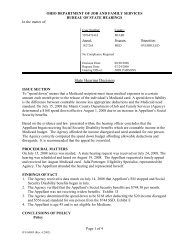Final TANF Rule as published in the Federal Register 4/12/1999
Final TANF Rule as published in the Federal Register 4/12/1999
Final TANF Rule as published in the Federal Register 4/12/1999
You also want an ePaper? Increase the reach of your titles
YUMPU automatically turns print PDFs into web optimized ePapers that Google loves.
17820 <strong>Federal</strong> <strong>Register</strong> / Vol. 64, No. 69 / Monday, April <strong>12</strong>, <strong>1999</strong> / <strong>Rule</strong>s and Regulations<br />
use of funds allowable under section<br />
404(a)(1).’’ Section 404(a)(1) of <strong>the</strong> Act<br />
refers to activities that are re<strong>as</strong>onably<br />
calculated to meet a purpose of <strong>the</strong><br />
<strong>TANF</strong> program. The use of <strong>the</strong> word<br />
‘‘o<strong>the</strong>r’’ <strong>in</strong>fers that <strong>the</strong> activities listed<br />
above (ee), i.e., (aa)–(dd) must also be<br />
re<strong>as</strong>onably calculated to accomplish a<br />
purpose of <strong>the</strong> program. Hence, not only<br />
must expenditures of funds pursuant to<br />
(ee) be re<strong>as</strong>onably calculated to<br />
accomplish a <strong>TANF</strong> purpose, so must<br />
State expenditures pursuant to (aa)–<br />
(dd): c<strong>as</strong>h <strong>as</strong>sistance, child care<br />
<strong>as</strong>sistance, educational activities, and<br />
adm<strong>in</strong>istrative costs (discussed <strong>in</strong> detail<br />
fur<strong>the</strong>r on).<br />
We mentioned <strong>in</strong> <strong>the</strong> NPRM that<br />
expenditures for ‘‘<strong>as</strong>sistance’’ for MOE<br />
purposes may take <strong>the</strong> form of c<strong>as</strong>h,<br />
certificates, vouchers, or o<strong>the</strong>r forms of<br />
disbursement, <strong>as</strong> determ<strong>in</strong>ed by <strong>the</strong><br />
State. MOE expenditures may also be for<br />
ongo<strong>in</strong>g, short-term, or nonrecurrent<br />
benefits. The def<strong>in</strong>ition of <strong>as</strong>sistance at<br />
§ 260.31 (§ 270.30 of <strong>the</strong> NPRM) does<br />
not limit <strong>the</strong> nature of State-funded aid<br />
provided to eligible families under<br />
<strong>TANF</strong> or separate State programs that<br />
can count <strong>as</strong> MOE. The authorization <strong>as</strong><br />
MOE of ‘‘any o<strong>the</strong>r use of funds<br />
allowable under section 404(a)(1)’’<br />
<strong>in</strong>dicates that Congress <strong>in</strong>tended all<br />
types of benefits provided to families<br />
under <strong>TANF</strong> under section 404(a)(1) of<br />
<strong>the</strong> Act should count <strong>as</strong> MOE. These can<br />
<strong>in</strong>clude ‘‘non<strong>as</strong>sistance’’ benefits such<br />
<strong>as</strong> nonrecurrent, short-term benefits.<br />
Thus, State expenditures with respect<br />
to eligible families for activities such <strong>as</strong><br />
pre-pregnancy family plann<strong>in</strong>g services,<br />
teen parent<strong>in</strong>g programs, youth and<br />
family counsel<strong>in</strong>g or support services,<br />
job tra<strong>in</strong><strong>in</strong>g or employment services, or<br />
forms of crisis <strong>as</strong>sistance that meet <strong>the</strong><br />
purposes of <strong>the</strong> program under section<br />
404(a)(1) may also count toward<br />
meet<strong>in</strong>g a State’s MOE requirement.<br />
However, such expenditures are subject<br />
to o<strong>the</strong>r limitations and restrictions<br />
under §§ 263.5 and 263.6 (§§ 273.5 and<br />
273.6 of <strong>the</strong> NPRM).<br />
In <strong>the</strong> NPRM, we also addressed<br />
additional limitations and restrictions.<br />
We <strong>in</strong>cluded some specific c<strong>as</strong>e<br />
situations that came to our attention and<br />
<strong>in</strong>vited comment on <strong>the</strong>se and o<strong>the</strong>r<br />
examples of aid for eligible families that<br />
States believed could qualify.<br />
(1) C<strong>as</strong>h Assistance<br />
This category <strong>in</strong>cludes c<strong>as</strong>h<br />
payments, <strong>in</strong>clud<strong>in</strong>g electronic benefit<br />
transfers, to meet b<strong>as</strong>ic needs; <strong>as</strong>sistance<br />
with work-related transportation costs;<br />
cloth<strong>in</strong>g allowances; and any child<br />
support collected on behalf of an<br />
eligible child that <strong>the</strong> State p<strong>as</strong>ses<br />
through to <strong>the</strong> eligible family.<br />
The preamble <strong>in</strong> <strong>the</strong> proposed rule<br />
po<strong>in</strong>ted out that section 5506(b) of Pub.<br />
L. 105–33 amended section<br />
409(a)(7)(B)(i)(I)(aa) of <strong>the</strong> Act to<br />
specifically allow <strong>as</strong>signed child<br />
support collected by <strong>the</strong> State and<br />
distributed to <strong>the</strong> family to count<br />
toward a State’s b<strong>as</strong>ic MOE so long <strong>as</strong><br />
<strong>the</strong> amount is disregarded <strong>in</strong><br />
determ<strong>in</strong><strong>in</strong>g <strong>the</strong> family’s eligibility for<br />
and amount of <strong>TANF</strong> <strong>as</strong>sistance.<br />
However, we neglected to po<strong>in</strong>t out that<br />
section 5506(b) also provided that <strong>the</strong><br />
<strong>as</strong>signed child support distributed to <strong>the</strong><br />
family must come from <strong>the</strong> State’s share<br />
of <strong>the</strong> amount collected. The law<br />
specifically refers to <strong>the</strong> amount<br />
collected and distributed to <strong>the</strong> family<br />
under section 457(a)(1)(B). Section<br />
457(a)(1)(B) provides that <strong>the</strong> State may<br />
reta<strong>in</strong> or distribute to <strong>the</strong> family its<br />
share of <strong>the</strong> support amount so<br />
collected. Thus, more accurately,<br />
section 409(a)(7)(B)(i)(I)(aa) expressly<br />
allows <strong>the</strong> State’s share of <strong>as</strong>signed<br />
child support amount collected on<br />
behalf of <strong>the</strong> family and distributed to<br />
<strong>the</strong> family to count toward a State’s<br />
b<strong>as</strong>ic MOE, provided that <strong>the</strong> State<br />
disregards <strong>the</strong> amount sent to <strong>the</strong> family<br />
<strong>in</strong> determ<strong>in</strong><strong>in</strong>g <strong>the</strong> family’s eligibility<br />
and amount of <strong>TANF</strong> <strong>as</strong>sistance. We<br />
have clarified this po<strong>in</strong>t <strong>in</strong> <strong>the</strong> f<strong>in</strong>al<br />
rule.<br />
C<strong>as</strong>h <strong>as</strong>sistance also <strong>in</strong>cludes State<br />
expenditures on behalf of eligible<br />
families <strong>as</strong> part of a State’s refundable<br />
Earned Income Tax Credit (EITC)<br />
program. Under a State EITC program,<br />
we determ<strong>in</strong>ed that only expenditures,<br />
i.e., <strong>the</strong> refundable portion of EITC<br />
payments actually paid to eligible<br />
families, may count <strong>as</strong> MOE. Also, if <strong>the</strong><br />
State had an EITC program <strong>in</strong> FY 1995,<br />
it may count <strong>the</strong> total amount of <strong>the</strong><br />
refundable portion of <strong>the</strong> EITC actually<br />
paid to eligible families only to <strong>the</strong><br />
extent that this amount exceeds <strong>the</strong> total<br />
amount of <strong>the</strong> refundable portion of <strong>the</strong><br />
EITC actually paid <strong>in</strong> FY 1995 (see<br />
§ 263.5).<br />
(2) Any O<strong>the</strong>r Use of Funds Allowable<br />
Under Section 404(a)(1)<br />
Section 404(a)(1) provides that <strong>TANF</strong><br />
funds may be used ‘‘<strong>in</strong> any manner that<br />
is re<strong>as</strong>onably calculated to accomplish<br />
<strong>the</strong> purpose of <strong>the</strong> <strong>TANF</strong> program,<br />
<strong>in</strong>clud<strong>in</strong>g to provide low <strong>in</strong>come<br />
households with <strong>as</strong>sistance <strong>in</strong> meet<strong>in</strong>g<br />
home heat<strong>in</strong>g and cool<strong>in</strong>g costs.’’ In<br />
§ 260.20 (§ 270.20 of <strong>the</strong> NPRM), we list<br />
<strong>the</strong> statutory purposes of <strong>the</strong> <strong>TANF</strong><br />
program.<br />
(3) Medical and Substance Abuse<br />
Services<br />
The statute does not prohibit <strong>the</strong><br />
expenditure of State MOE funds on<br />
medical expenditures. Therefore, States<br />
may count expenditures of <strong>the</strong>ir own<br />
funds to provide treatment services to<br />
<strong>in</strong>dividuals seek<strong>in</strong>g to overcome drug<br />
and/or alcohol abuse when <strong>the</strong>se<br />
services <strong>as</strong>sist <strong>in</strong> accomplish<strong>in</strong>g <strong>the</strong><br />
purposes of <strong>the</strong> program. This policy<br />
would also comport with both <strong>the</strong><br />
Adm<strong>in</strong>istration’s support for drug<br />
rehabilitation services and <strong>the</strong><br />
congressional call for State flexibility <strong>in</strong><br />
<strong>the</strong> operation of welfare programs.<br />
We rem<strong>in</strong>ded States that such<br />
expenditures must be consistent with<br />
<strong>the</strong> purposes of <strong>the</strong> program and made<br />
to, or on behalf of, eligible families. We<br />
also rem<strong>in</strong>ded States that section<br />
408(a)(6) bars <strong>the</strong> use of <strong>Federal</strong> <strong>TANF</strong><br />
funds for medical services. Therefore,<br />
States us<strong>in</strong>g MOE funds to provide<br />
medical treatment services may not<br />
comm<strong>in</strong>gle State and <strong>Federal</strong> <strong>TANF</strong><br />
funds. In addition, any State<br />
expenditures on medical services that<br />
are used to obta<strong>in</strong> <strong>Federal</strong> match<strong>in</strong>g<br />
funds under <strong>the</strong> Medicaid program<br />
would not count <strong>as</strong> MOE. (Refer to <strong>the</strong><br />
discussion under § 263.6.) <strong>F<strong>in</strong>al</strong>ly, State<br />
expenditures on medical and substance<br />
abuse services may only count <strong>as</strong> MOE<br />
subject to <strong>the</strong> ‘‘new spend<strong>in</strong>g’’<br />
limitations set forth <strong>in</strong> § 263.5.<br />
(4) Juvenile Justice<br />
State funds used to pay <strong>the</strong> costs of<br />
benefits or services provided to children<br />
<strong>in</strong> <strong>the</strong> juvenile justice system and<br />
previously matched under <strong>the</strong> EA<br />
program do not count toward MOE.<br />
More specifically, <strong>as</strong> juvenile justice<br />
services do not meet any of <strong>the</strong> purposes<br />
of <strong>the</strong> <strong>TANF</strong> program, <strong>the</strong>y are not an<br />
allowable use of funds under section<br />
404(a)(1).<br />
While some States may expend <strong>the</strong>ir<br />
<strong>Federal</strong> <strong>TANF</strong> funds for this purpose,<br />
under section 404(a)(2), <strong>the</strong> def<strong>in</strong>ition of<br />
‘‘qualified State expenditures,’’ for MOE<br />
purposes, does not <strong>in</strong>clude <strong>the</strong> reference<br />
to section 404(a)(2). Therefore, we have<br />
concluded that Congress did not <strong>in</strong>tend<br />
to automatically qualify all previously<br />
authorized IV–A expenditures <strong>as</strong> MOE.<br />
States that expend <strong>Federal</strong> <strong>TANF</strong> funds<br />
for this purpose, under section<br />
404(a)(2), must not comm<strong>in</strong>gle State<br />
funds with <strong>Federal</strong> <strong>TANF</strong> funds if <strong>the</strong>y<br />
wish <strong>the</strong> State funds to count <strong>as</strong> MOE.<br />
(5) State ‘‘Ra<strong>in</strong>y Day’’ Funds<br />
Some States <strong>in</strong>quired whe<strong>the</strong>r State<br />
funds allocated or set <strong>as</strong>ide dur<strong>in</strong>g a<br />
fiscal year <strong>as</strong> a ‘‘ra<strong>in</strong>y day’’ fund, to act<br />
<strong>as</strong> a hedge aga<strong>in</strong>st any economic<br />
downturn, could count <strong>as</strong> MOE. While<br />
we understand State <strong>in</strong>tent, <strong>the</strong>se<br />
allocations or set-<strong>as</strong>ides are not<br />
expenditures. States must actually<br />
expend funds on behalf of eligible


